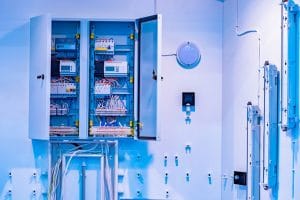 With the prevalence of technology in most of today’s industries, the need for ancillary solutions such as electrical cooling has grown increasingly more important over the years. While this need can take on different forms in different industries, one of the most common electrical cooling needs involves the consistent cooling of electrical enclosures and control panels. Most forms of industrial technologies come with multiple enclosures and high-performance control panels that can be the source of high amounts of electrical waste heat. With the advent of heat exchangers designed to optimize results and the use of resources in electrical cooling, companies have benefited significantly from the ability to cool electrical control panels more efficiently.
With the prevalence of technology in most of today’s industries, the need for ancillary solutions such as electrical cooling has grown increasingly more important over the years. While this need can take on different forms in different industries, one of the most common electrical cooling needs involves the consistent cooling of electrical enclosures and control panels. Most forms of industrial technologies come with multiple enclosures and high-performance control panels that can be the source of high amounts of electrical waste heat. With the advent of heat exchangers designed to optimize results and the use of resources in electrical cooling, companies have benefited significantly from the ability to cool electrical control panels more efficiently.
The growing need for modern electrical cooling
Cooling electrical control panels and other enclosures isn’t the only electrical thermal management need that modern companies have. However, it’ sone of the most common, which is why heat exchangers first became popular as a more streamlined method of achieving consistent, high-performance electrical enclosure cooling. The need to streamline the process of electrical cooling has grown more substantial as companies have invested in increasingly more powerful and streamlined technological solutions. The conventional methods that companies employed to cool their technologies, including air conditioning and air compressing applications, haven’t always been able to keep up.
Streamlining the process of cooling control panels
To make it more efficient to maintain their technologies, companies have benefited increasingly more frequently from the use of more advanced electrical cooling solutions. In addition to making the process of preventing electrical overheating more efficient and cost-effective, modern heat exchangers have also made it more convenient for companies to keep up with increasing electrical cooling demands. They achieve this by utilizing more natural and eco-friendly methods of transferring waste heat, rather than conventional means of circulating chilled air throughout an enclosure. Transferring waste heat can be accomplished by taking advantage of a cooling fluid’s latent heat of vaporization and providing a path for the fluid to flow away from electrical components once it’s absorbed enough waste heat.
The implications beyond cooling electrical enclosures
As companies in different industries have benefited from more efficient electrical enclosure cooling, the implications of utilizing more efficient means of transferring heat have also become more substantial. The ability to efficiently maintain proper temperatures within all electrical enclosures at minimal cost and with minimal energy has helped companies save significantly on overhead costs. Also, the ability to rapidly and efficiently manage waste heat at scale has led to the use of modern heat exchangers for thermal management process far beyond electrical enclosure cooling.
For more information about the impact of cooling control panels more efficiently, call Noren Thermal Solutions in Taylor, TX, at 866-936-6736.







